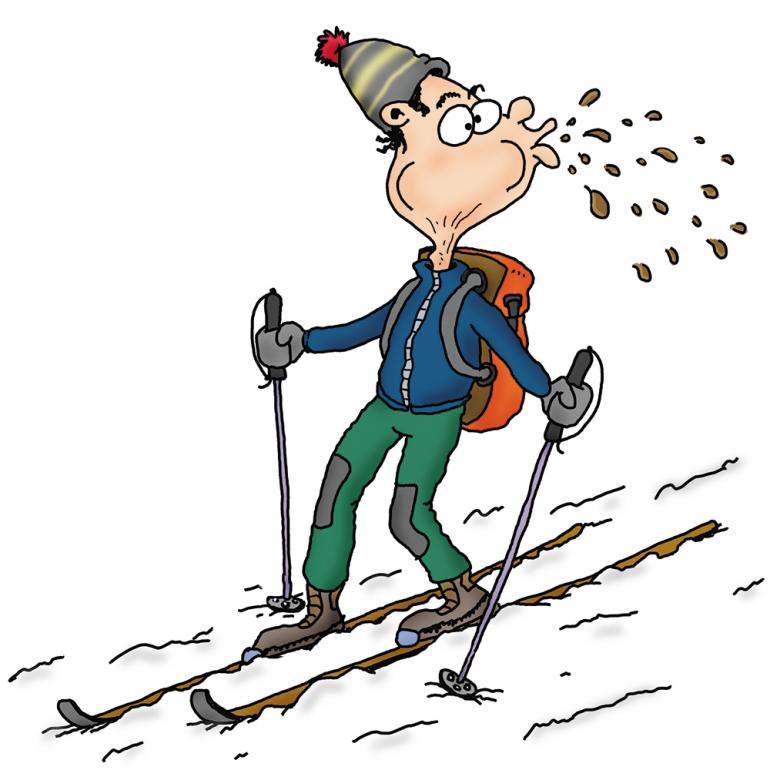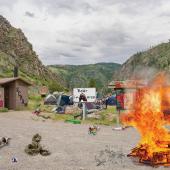A Dip in the Tobacco
The verdict's in, and smoking is out.
Clean indoor air laws are on the increase across the nation. Cigarette use is down. And there are now more people in the U.S. who have quit smoking than the 46 million Americans who still do. But before you go thinking tobacco is a thing of the past, consider this: smokeless tobacco companies may be eyeing you and your pals like a new territory to colonize. Tobacco companies are marketing heavily to outdoor enthusiasts—people who like to try new things, need their hands free, and know and treasure biochemical rush.
The smokeless tobacco marketing boom actually began in the late 1960s and early 1970s. The primary consumers back then were older, rural white males with manual-labor jobs. Smokeless tobacco was a hard sell: new users had to endure a harsh taste and even nausea. To create new markets, the companies came up with moist snuff—produced in a wide assortment of flavors, strengths, and package types—to lure in new users, then graduate them to stronger (and more addictive) chew.
To expand the customer base, companies introduced images of freedom, ruggedness, independence, and the great outdoors. Ads began featuring cowboys, fishermen, hunters, and—more recently—mountain bikers, kayakers, climbers, and extreme skiers. The image portrayed is of tough, strong, skillful men who engage the natural world. The U.S. Smokeless Tobacco Company (Copenhagen and Skoal) overtly supports organizations promoting fishing, hunting, motor sports, and, especially, rodeo. Skoal’s internet homepage states, “with retail sales surpassing $1 billion, it has become one of America’s favorite and most widely recognized brands, synonymous with outdoor activities and recreation.”
From 1985 to 2001, advertising expenditures of U.S. smokeless tobacco companies rocketed from $80 million to $236 million per year. Free samples were available through mail-in offers in magazines like Field and Stream, Outdoor Life, and Sporting News. Between 1997 and 2001, the United States Tobacco Company increased its ad expenditures in youth magazines from $3.6 million to $9.4 million. These days, smokeless ads show up in Sports Illustrated and Rolling Stone.
What these ads don’t tell you is that 28 known carcinogens exist in smokeless tobacco, which can lead to cancers of the cheeks, lips, gums, tongue, esophagus, larynx, pharynx, stomach, and pancreas. Every year, chew is responsible for about 27,000 new cases of oral cancer and 9,000 deaths. Smokeless tobacco causes everything from bad breath to tooth decay to gum disease to bone loss. The nicotine in one chew or dip is equal to about four cigarettes. The addiction, therefore, can be that much stronger, more debilitating, and more difficult to break. Nicotine is known to cause cardiovascular problems like high blood pressure, heart disease, and stroke. Tobacco actually kills more people from cardiovascular disease than it does from cancer.
Ultimately the use of kayakers, climbers, and mountain bikers in contemporary ads may not be as widespread as the traditional images of cowboys and baseball players, but the outdoor audience is still a big target. Only time will tell if smokeless tobacco becomes mainstream, or goes the way of the Marlboro Man.
Dana McMurray is a Senior Community Health Specialist working for the Tobacco Prevention Program at the Missoula City-County Health Department. If you or a friend are a smokeless user and want to quit, call the Montana Tobacco Quit Line at 866-485-QUIT.
A Local Detox (Without the Celebrities)
Every year, a few insane residents of the Gallatin Canyon plunge into the Taylor Fork River south of Big Sky. This isn’t a summertime cooling-off jaunt. It’s spring and the water’s seriously cold—it's a test of grit. Apparently, this is good for us. The Taylor Fork is milky with bentonite in May, which leeches into the water at the base of the Taylor-Hilgard Mountains. Which means our frigid frolicking is healthy for our skin. But I’m happy with just being hard-core, because there are simpler ways of obtaining bentonite.
You can use bentonite as a powerful detoxification aide. Hydrated calcium bentonite absorbs toxins and impurities from our bodies. Maybe we’re onto a good thing swimming in the river. That would count as hydrated. But less demanding, over-the-counter bentonite comes in powder, liquid, capsules, or mudpacks. Detox to go. Dead easy.
Now don’t go buying a bunch and get carried away. Bentonite is potent, and Bozeman doctor Michael Lang, M.D., recommends against everyday use. “Bentonite absorbs quite a bit. You don’t want that all the time. It’s best to use it when you have something like diarrhea—when there are lots of toxins floating around in the gut.” Eeeuuw. All right, but what about topical applications? “Chicken pox and bee stings would be a good time to make a mud pack to put on your skin,” he advises. Just make sure you read the directions.
If, however, you must be “one with nature” and bathe in a river, you’ll find bentonite deposits throughout the world. But check what else is around before you take a dip. “There are streams where you might be concerned about heavy metals such as arsenic,” Dr. Lang warns. Hmmm. The Taylor Fork still sounds good to me. See you there.
-Sarah Stephan













